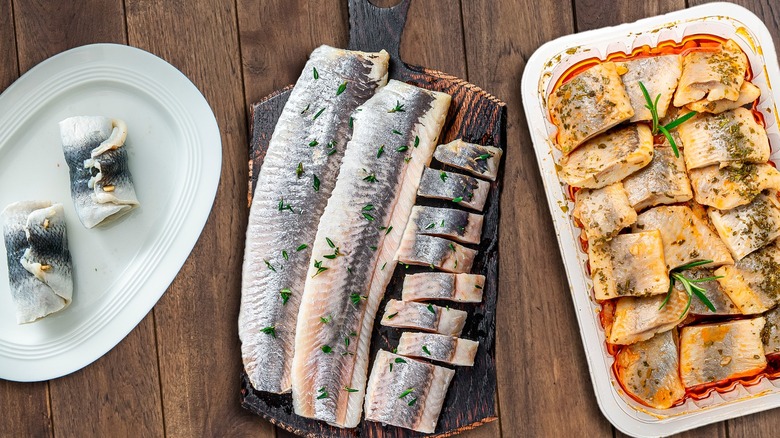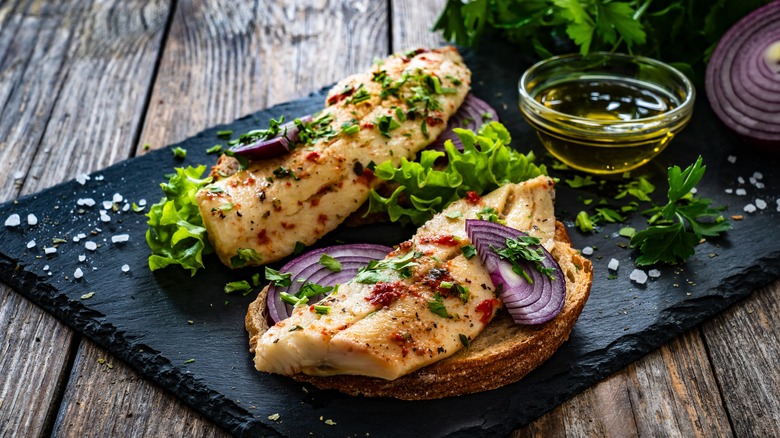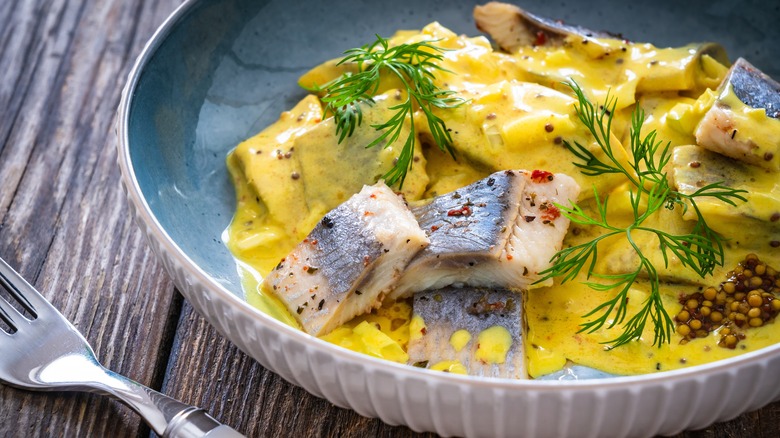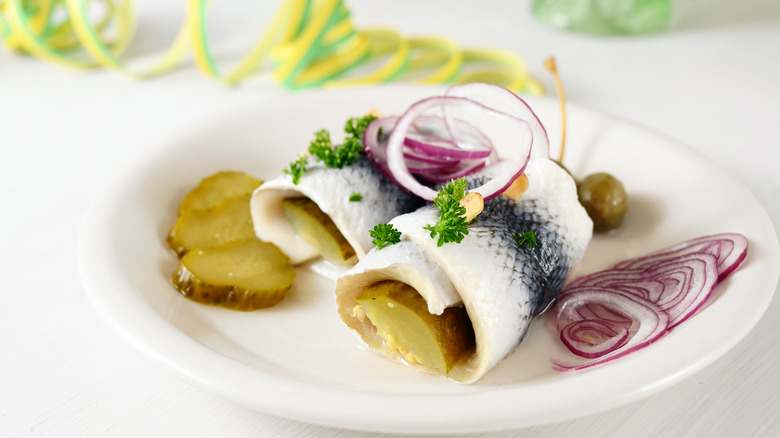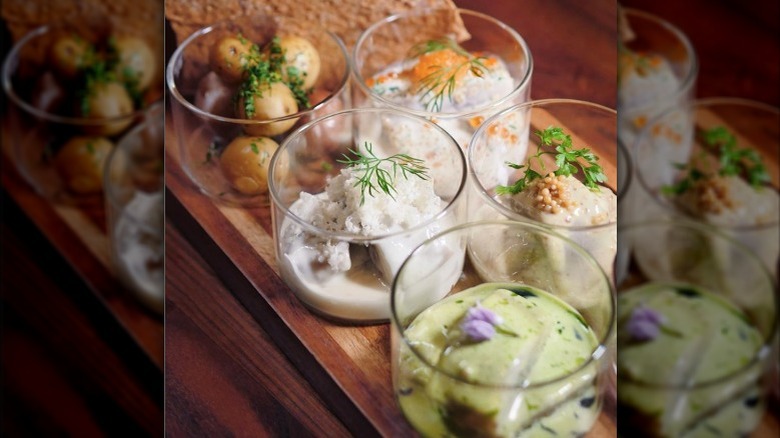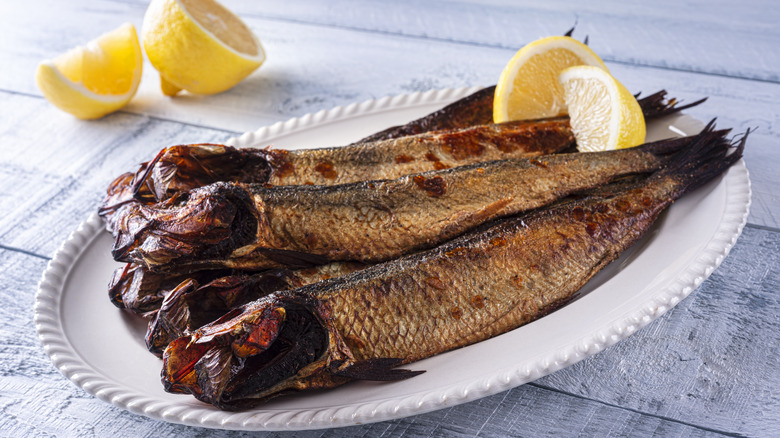The 5 Best Ways To Prepare Herring, Explained By A Michelin-Awarded Chef
Herring may not be the first type of fish you think of to put on your plate, but it's a popular little fish eaten in many parts of the world, specifically Sweden. Due to its location near the Baltic Sea and the North Atlantic, Sweden is an abundant source of fish. We wanted to learn more about the best ways to prepare herring, so we reached out to Emma Bengtsson, executive chef of Aquavit, a double Michelin-starred New York City restaurant that specializes in a variety of seafood such as Chilean sea bass, king salmon, and matjes herring. You can experience the flavor of Aquavit during the City Harvest BID event on October 29, 2024, where more than 50 chefs and restaurants offer a taste of New York in order to help feed those in need.
Herring has a long history of feeding people. Bengtsson tells us, "Since herring is a great fish to pickle, it played a major role during the times before refrigeration was invented." It's a great option for preserving because of its high oil content, which also contributes to an increased amount of omega-3 fatty acids. The fat, coupled with the protein, make it a great food for survival, especially during winter months. Beyond just survival, Bengtsson says, "It plays a big role in our cultural traditions where we normally begin every holiday meal with herring, including Midsummer, Christmas, and Easter."
Classic pickling
If you're an avid fisherman and catch your own herring, preserving them is convenient and easy to do. Though there are a few different methods for preserving herring, curing is simple and also one of the best ways to enjoy eating it. "The most popular, and familiar way to prepare herring is to pickle it," Emma Bengtsson tells us, "The fish is cured in a ratio of 1:2:3 of vinegar, sugar, and water. It's common to add spices and root vegetables such as onion and carrots." Herring is sometimes pickled in wine or brine as well, adding to the range of pickling styles. The different preparation methods are named depending on the additional ingredients used to cure the fish.
Classic pickled herring is the sweet-and-sour version that's typically served at a Midsummer dinner party, but there's also a heavier sour version, such as soused, which involves pickling herring in just a vinegar base with onions and spices. Some preparations feature pickled herring in mustard, curry, or cream sauces. Classic Swedish pickled herring is often served with crisp rye bread for a contrasting textural bite.
Marinated pickling
You can find or make pickled herring in a number of ways, using different types of brines and experimenting with various seasonings. Though herring pickled in the traditional Swedish way involves a simple vinegar base, you can play around with your additional flavors, thus broadening your recipe horizon. "To dress up the pickled herring, I like to create different marinades," says Emma Bengtsson. "One of my favorites is a horseradish sauce. It's a mixture of mayonnaise, crème fraîche, and fresh grated horseradish." The tang from the vinegar pairs nicely with the heat from horseradish. Switching up the pickling marinade gives you a completely different culinary experience.
Though changing the marinade alters your taste buds' adventure, if your recipe calls for herring, try to use herring. "Most of the herring dishes we eat are created to highlight the flavor of the herring, and I wouldn't consider swapping with sardines," says Bengtsson. Sardines and herring are sometimes confused with each other, but sardines are smaller and milder in taste. If you're simply topping a salad with the fish, you can add either fish and end up with a somewhat similar dish. But Bengtsson warns that results will certainly vary. "They are two completely different fish," she says. "It's like swapping out pasta for rice. It can be done, but it will change the whole purpose of the dish."
Rollmop
Rollmop is another popular and delicious preparation for pickled herring. However, it doesn't hail from Sweden like the traditional pickled version; it hails from Germany. German rollmops consist of pickled herring fillets that are rolled around a savory filling, which is typically onions, carrots, or gherkins, according to Emma Bengtsson. "Sometimes capers or spices are added," she tells us. "The rolled herring is typically secured with a toothpick and served cold, often as part of a smorgasbord or buffet." Rollmops are traditionally served on top of the combined mashing of potatoes, onions, beetroot, and corned beef — a German dish referred to as labskaus.
Bismarck herring is prepared similarly to rollmops, except this pickled herring is made with a more sour marinade that may include vinegar, lemon, or wine. It's also served with onions or carrots, but unlike rollmops, bismarck herring is not rolled and is instead cut into short, large chunks. Spices in the pickling solution may include mustard seed, peppercorns, cloves, and allspice. Bismarck herring may also be seasoned with chiles, bay, or dill.
Matjes
Matjes herring doesn't just refer to how it's prepared; it also signifies when the herring is caught. Emma Bengtsson tells us, "Matjes herring is a type of young, immature herring that is typically caught in the spring." Spring is the season when herring finds its way to shallow waters to spawn, she explains, which is also typically the best time to go fishing for herring. The young herring, she says, are "cured in a pickling liquid with added spices such as sandalwood, allspice, clove, and beet powder." If you've never had pickled herring before, Bengtsson suggests trying matjes as your starter herring for your first experience.
For those who might find traditional pickled herring to be too intense, the matjes preparation offers a subtler flavor for your taste buds. It's Bengtsson's go-to preparation method for herring. It's also the one that's served at Aquavit because matjes delivers a sweeter and milder herring profile that she feels is "very pleasing to the palate."
Smoked
Smoked herring is quite popular in various forms. Whether it's kippers, bloaters, or buckling, smoking herring is a great way to preserve it, says Emma Bengtsson. The high oil content plus the herring's size makes it a good candidate for cold or hot smoking. And since herring is caught in large schools, according to Bengtsson, it's plentiful and readily available in order to preserve it. If you're reaching for canned smoked herring instead of smoking it yourself, ensure you choose the right brand and keep it simple with your recipe. Creating fish tacos with canned smoked herring is a fantastic weeknight meal that's quick and easy to throw together.
Bengtsson notes, "Cooking the herring over fire with some birch or pine adds a lovely smoky flavor." How to accomplish this? She says, "This works best with a whole, gutted herring." This type of smoked herring is referred to as buckling and it features a slightly less smoky flavor than kippers, which are a common type of whole, gutted herring that has been cold-smoked. Kippers typically appear red from the cold-smoking process.
